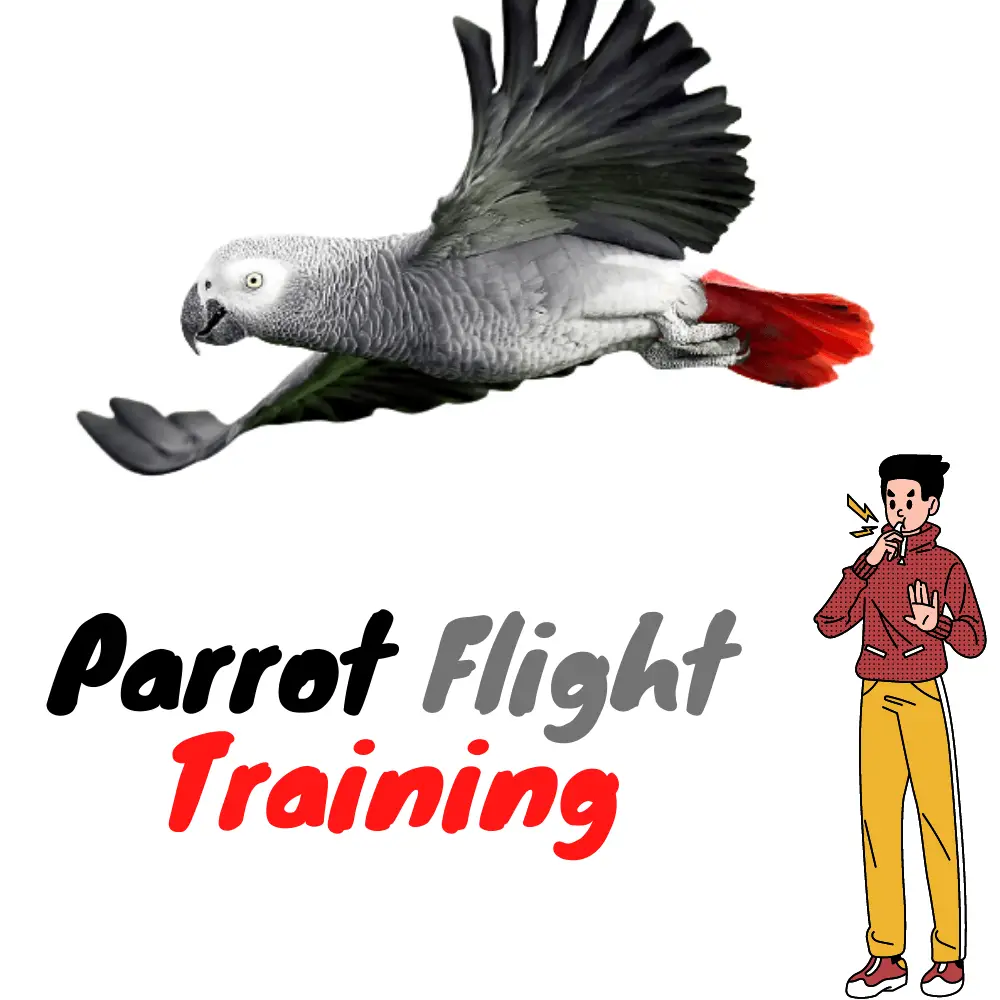
Parrot in flight Having so far little experience in free flight, I am sending you an article by Margaux Deman, a recognized behaviorist who practices it daily. Good reading.
Contents
hide
Free flight: received ideas
When you don’t do a free flight with your parrots, you imagine a lot about the preparation of the bird and the potential dangers of the practice. These dangers are often not where we expect them the most…
I decided to make a small article that dismantles the received ideas and answers the questions often asked.
Aren’t you afraid of birds of prey?
In France, and elsewhere, there is a great diversity of diurnal (living during the day) and nocturnal (living at night) raptors. You may find it strange that I mention the existence of these when our parrots are only supposed to fly during the day, but I intend to explain why it is important to mention them.
Imagine that most raptors are not able to attack and hunt our parrots. Large raptors such as buzzards and kites prefer to attack easy and habitual prey. Buzzards have a relatively slow flight and could not overtake a fleeing parrot even if they wanted to. Kites, on the other hand, are faster fliers and can sometimes come and annoy parrots, especially large parrots like macaws, probably because they consider them intruders on their territory or breeding site. It will then be a question of deterrence and not an act of predation. Once within range of the parrot, the bird pretends to attack it before changing direction.
Chases can sometimes be impressive, and inexperienced young birds can get the jitters of their lives! Birds that have been flying for years can literally come and annoy raptors to spice up their outing a bit.
Chases can sometimes be impressive, and inexperienced young birds can get the jitters of their lives! Birds that have been flying for years can literally come and annoy raptors to spice up their outing a bit.
Small raptors like hawks and sparrowhawks are often not a danger outdoors, although they can hunt dove-sized birds. They favor habitual prey and are wary of novelty. A small, colorful and noisy bird is, therefore, more frightening than appetizing in their eyes. However, you have to be wary of sparrowhawks, young ones in particular (we see them in early spring), because they are often hungry and fearless (not even you). Hungry, yes, but clumsy. Hawk attacks are common in the aviary on small species, but extremely rare in free flight.
Large parrots have absolutely nothing to fear from them.
If you choose a flight site on the edge of the forest, you can however cross the path of a goshawk. The latter would not attack a parrot of unusual color and size, but an African Grey Parrot or Macaw Parrot would quickly be mistaken for its favorite prey, the wood pigeon. Caution is required in environments in wooded areas.
African grey flying

I mentioned nocturnal birds of prey because they can pose a danger to small species. Indeed, if the outings have not been well prepared and the bird has to spend the night outside, it is then exposed to nocturnal predators. Dark-colored, blue, or green individuals survive longer than light-colored, yellow, or white individuals. If they have disappeared from their dormitory during the night, it’s not a very good sign…
Indeed our parrots are strictly diurnal and no longer move after nightfall.
Indeed our parrots are strictly diurnal and no longer move after nightfall.
Large parrots are not affected and are rarely the target of nocturnal predators.
The wild species to be wary of in free flight are especially corvids (crows, magpies, common ravens in mountainous regions) as well as gulls. These birds are adept at harassment, which can quickly destabilize and carry a still inexperienced parrot very far.
How to Teach Your Bird to Fly to You! | Parrot Flight Recall Training
https://www.youtube.com/watch?v=eVeCxaBGgDA
SOURCE:ElleAndTheBirds
My parrot and I are very friendly, which makes him a good candidate for a free flight.
Guess not!
The complicity is not essential to the practice of free flight so that one can take out a bird that masters the basics but with which you do not necessarily have much affinity.
The key is not in the human/bird relationship but in the self-confidence OF THE PARROT.
A bird close to you but fearful, without insurance, will make a poor sailor while a bird more distant but very assured and reckless will make a reliable individual in free flight.
The key is not in the human/bird relationship but in the self-confidence OF THE PARROT.
A bird close to you but fearful, without insurance, will make a poor sailor while a bird more distant but very assured and reckless will make a reliable individual in free flight.
It is not the bond that unites you with your parrot that encourages him to stay with you, but simply his nature as a social and prey animal.
Parrots, like many prey animals, always seek a state of relative safety. Familiar surroundings and landmarks (of which you are a part) are always more reassuring to him than the unknown and new. Birds are curious and like to explore new surroundings. That said, they are always happy to return to their home with their comfort and their little habits.
In addition, most species are territorial and are therefore attached to a more or less fixed area.
In addition, most species are territorial and are therefore attached to a more or less fixed area.
Aren’t you afraid of wind turbines?
I am often asked the question because I have been taking my parrots for years to let off steam in the wind farms near my home.
In photos and videos, wind turbines always appear closer than they actually are. I make sure to keep enough distance so that the parrots do not have to evolve nearby.
Even so, in an open environment parrots tend to fly low, and much lower than the blades of wind turbines, which exposes them to an extremely low risk of accidents, or even non-existent. If the wind turbines were surrounded by trees (let’s say), the risk of the birds flying higher and near the blades would be much greater, considering that I choose their flight site so that the wind turbines are within easy reach. wings.
Of course, I’m cautious and that’s not the case.
Small house wind turbines, which are sometimes seen on the roofs of houses in the countryside or in peri-urban areas, represent a real danger. Accidents have already been recorded on wild birds as well as parrots in free flight. It is therefore essential to ‘check’ the environment to eliminate a maximum of dangerous elements such as this one.
It is better to free-fly with a badly-flying bird so that it does not go very far.
This information is completely wrong! On the contrary, the parrot must fully control its wings, to escape the dangers of the outside and better come back if it flies away or perches in a tree.
Who says clumsy flight says lack of self-confidence. If I regularly mention this “self-confidence” it is because it is a key point in the success of free flight training. A parrot who masters his wings and is confident in his flight will know how to solve all difficulties and return to his human without assistance.
Who says clumsy flight says lack of self-confidence. If I regularly mention this “self-confidence” it is because it is a key point in the success of free flight training. A parrot who masters his wings and is confident in his flight will know how to solve all difficulties and return to his human without assistance.
After how many years is his parrot ready to face the outside world?
For many “novices”, preparing their bird for the free flight can seem long. In fact, a parrot may be ready to go out after a few days or weeks of light training.
It’s all about age!
Indeed juveniles are much better candidates than adults, for the simple reason that the young are genetically disposed to control their wings at the time of flight (age from which they leave the nest). Outdoor flight is acquired very quickly, almost “instinctive”.
On the other hand, adult birds that have passed this learning period evolve much more slowly. They have often developed blockages, a lack of self-confidence, and apprehensions over time, for height and/or distance.
For example, parrots may have difficulty rappelling over long distances, simply because they doubt their abilities and anticipate a possible fall.
Indeed juveniles are much better candidates than adults, for the simple reason that the young are genetically disposed to control their wings at the time of flight (age from which they leave the nest). Outdoor flight is acquired very quickly, almost “instinctive”.
On the other hand, adult birds that have passed this learning period evolve much more slowly. They have often developed blockages, a lack of self-confidence, and apprehensions over time, for height and/or distance.
For example, parrots may have difficulty rappelling over long distances, simply because they doubt their abilities and anticipate a possible fall.
The problem of height is often mentioned in many flight experiences with slightly older individuals. If flying very high is not difficult, descending on the other hand is much more complicated.
For adult birds, longer work is necessary before considering an outdoor outing, whereas with a young parrot just weaned, everything can go extremely quickly.
Parrot Flight Recall Training Tutorial
https://www.youtube.com/watch?v=gUq0qqWQnIo
SOURCE:Feathered Friends
Are electric wires a danger?
This is also a frequently asked question.
Unless they are high voltage lines, the danger of which is no longer to be proven for wild birds, the electric wires that we cross on the edges of the roads are not a danger for our birds.
It is rare for large species of parrots to land there. Small species may go there more frequently but do not seek to damage the wires.
Even in the wild, parakeets and parrots settled in urban areas regularly exploit the wires as perches.
In the training that I propose, however, I explain how to dissuade your parrot from landing in potentially dangerous areas. Moreover, chimneys (which may interest mature birds), as well as busy roads, highways, railway lines, and car roofs, are even more dangerous.



















